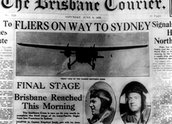


Smithy (1946)
Synopsis
A young Australian pilot in the Royal Flying Corps is shot in the foot while flying over the Western Front in 1917. Charles Kingsford Smith (Ron Randell) finishes the war with a Military Cross and a burning desire to do something big in aviation. He tries to enter the England to Australia Air Race in 1919, but the Australian Prime Minister, Mr WM Hughes (played by himself) personally prohibits him, and so he decides to become the first man to fly from the USA to Australia, across the Pacific. This flight, with Charles Ulm, makes him world famous, but his attempt to run an airline in Australia fails with the crash of one of his aircrafts. In the early 1930s he receives a knighthood, but is reduced to running joy flights to make a living. He marries Mary Powell (Muriel Steinbeck) and they have a son, but Sir Charles is reluctant to give up his attempts to set records. He crosses the Pacific again, but this time from Australia to the USA, and in a single engine aeroplane, with PG (Bill) Taylor as navigator (playing himself). After a near disastrous flight to New Zealand, ‘Smithy’ retires his ‘old bus’, the modified Fokker he dubbed the Southern Cross. He is troubled by premonitions that he will die young, like other great Australian aviators. In 1935, flying from England to Australia, his plane disappears over the Indian Ocean, never to be found.
Curator’s notes
Smithy was a major achievement for Ken G Hall, a biopic that showed off all of his considerable gifts as a storyteller. Unfortunately it was to be his last feature, and its production coincided with the beginning of the end for the Australian film industry, which he had done so much to establish before the Second World War.
Smithy was made at Cinesound, but not for Cinesound. The money came from Columbia Pictures’ Australian division, which was seeking a way to get frozen box office funds out of war-time Australia. The Columbia Australia head Nick Pery asked Hall to make a film about a world famous Australian. The idea was to make the film in Australia and reap the profits in America, as well as Australia. Hall considered making a film about Ned Kelly or Nellie Melba, but preferred the story of Charles Kingsford Smith, because he was well known in the US.
Hall was able to utilise his by now considerable skills with back projection (see Thoroughbred), and the Australian government gave him the full cooperation of the Royal Australian Air Force. The original Southern Cross, which the government had acquired ten years earlier, was in crates at Canberra airfield. Hall had it put back together and it was flown in the film by two men who had flown with Kingsford Smith – PG (Bill) Taylor, himself a famous airman, and Harry Purves. Taylor appears as himself, as do several other notables, chiefly the ex-Prime Minister Billy Hughes, who had to be photographed only from his left side, to conceal his hearing aid.
The film launched Ron Randell on an international career in Hollywood, but it was not popular with Harry Cohn, the head of Columbia. Ken Hall writes in his autobiography that Cohn removed Nick Pery’s name as producer when the film was shown in the US, along with any reference to the film having been made in Australia. Cohn took 27 minutes out of the film, including all of the scenes with Billy Hughes.
The film was released in the US as Pacific Adventure and died, but it was a major success at the Australian box office. Ironically, it was one of the last home-grown successes before the industry in Australia was virtually shut down. In 1947, Greater Union, still starved of international films by the recent war, sought an alliance with the then all-powerful Rank Organisation in the UK. Rank bought a half share in Greater Union, but this helped to kill off Australian production. Rank began to make films in Australia (see Bush Christmas), but it was not interested in financing and distributing Australian films that would compete with its own productions. Cinesound, which was a part of Greater Union at the time of the Rank buy-in, never made another feature film, despite its prewar record of consistent box office appeal (17 features, only one of which didn’t make money).
Smithy was screened on the ABC in 1958, making it the first Australian feature film to be shown on television.
- Overview
- Curator’s notes
- Video 3 clips

- Principal credits
- Find a copy
- Comments 3
- Reviews 1



